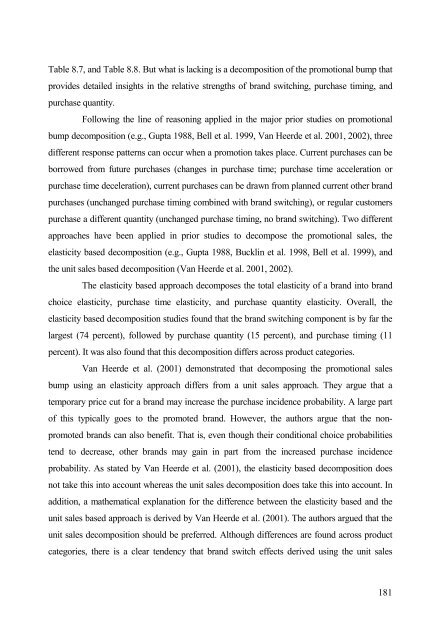Analysis of Sales Promotion Effects on Household Purchase Behavior
Analysis of Sales Promotion Effects on Household Purchase Behavior
Analysis of Sales Promotion Effects on Household Purchase Behavior
Create successful ePaper yourself
Turn your PDF publications into a flip-book with our unique Google optimized e-Paper software.
Table 8.7, and Table 8.8. But what is lacking is a decompositi<strong>on</strong> <str<strong>on</strong>g>of</str<strong>on</strong>g> the promoti<strong>on</strong>al bump that<br />
provides detailed insights in the relative strengths <str<strong>on</strong>g>of</str<strong>on</strong>g> brand switching, purchase timing, and<br />
purchase quantity.<br />
Following the line <str<strong>on</strong>g>of</str<strong>on</strong>g> reas<strong>on</strong>ing applied in the major prior studies <strong>on</strong> promoti<strong>on</strong>al<br />
bump decompositi<strong>on</strong> (e.g., Gupta 1988, Bell et al. 1999, Van Heerde et al. 2001, 2002), three<br />
different resp<strong>on</strong>se patterns can occur when a promoti<strong>on</strong> takes place. Current purchases can be<br />
borrowed from future purchases (changes in purchase time; purchase time accelerati<strong>on</strong> or<br />
purchase time decelerati<strong>on</strong>), current purchases can be drawn from planned current other brand<br />
purchases (unchanged purchase timing combined with brand switching), or regular customers<br />
purchase a different quantity (unchanged purchase timing, no brand switching). Two different<br />
approaches have been applied in prior studies to decompose the promoti<strong>on</strong>al sales, the<br />
elasticity based decompositi<strong>on</strong> (e.g., Gupta 1988, Bucklin et al. 1998, Bell et al. 1999), and<br />
the unit sales based decompositi<strong>on</strong> (Van Heerde et al. 2001, 2002).<br />
The elasticity based approach decomposes the total elasticity <str<strong>on</strong>g>of</str<strong>on</strong>g> a brand into brand<br />
choice elasticity, purchase time elasticity, and purchase quantity elasticity. Overall, the<br />
elasticity based decompositi<strong>on</strong> studies found that the brand switching comp<strong>on</strong>ent is by far the<br />
largest (74 percent), followed by purchase quantity (15 percent), and purchase timing (11<br />
percent). It was also found that this decompositi<strong>on</strong> differs across product categories.<br />
Van Heerde et al. (2001) dem<strong>on</strong>strated that decomposing the promoti<strong>on</strong>al sales<br />
bump using an elasticity approach differs from a unit sales approach. They argue that a<br />
temporary price cut for a brand may increase the purchase incidence probability. A large part<br />
<str<strong>on</strong>g>of</str<strong>on</strong>g> this typically goes to the promoted brand. However, the authors argue that the n<strong>on</strong>promoted<br />
brands can also benefit. That is, even though their c<strong>on</strong>diti<strong>on</strong>al choice probabilities<br />
tend to decrease, other brands may gain in part from the increased purchase incidence<br />
probability. As stated by Van Heerde et al. (2001), the elasticity based decompositi<strong>on</strong> does<br />
not take this into account whereas the unit sales decompositi<strong>on</strong> does take this into account. In<br />
additi<strong>on</strong>, a mathematical explanati<strong>on</strong> for the difference between the elasticity based and the<br />
unit sales based approach is derived by Van Heerde et al. (2001). The authors argued that the<br />
unit sales decompositi<strong>on</strong> should be preferred. Although differences are found across product<br />
categories, there is a clear tendency that brand switch effects derived using the unit sales<br />
181

















